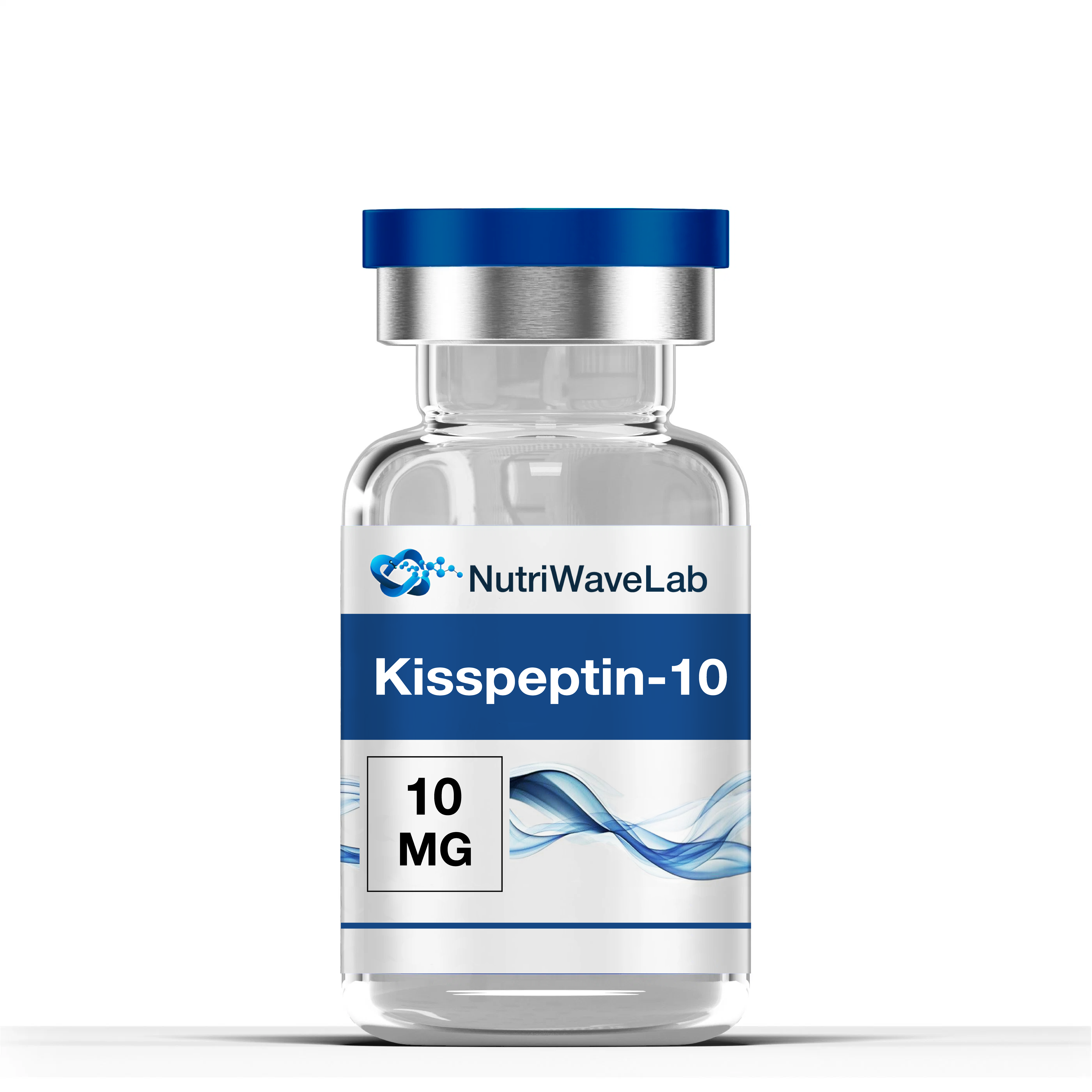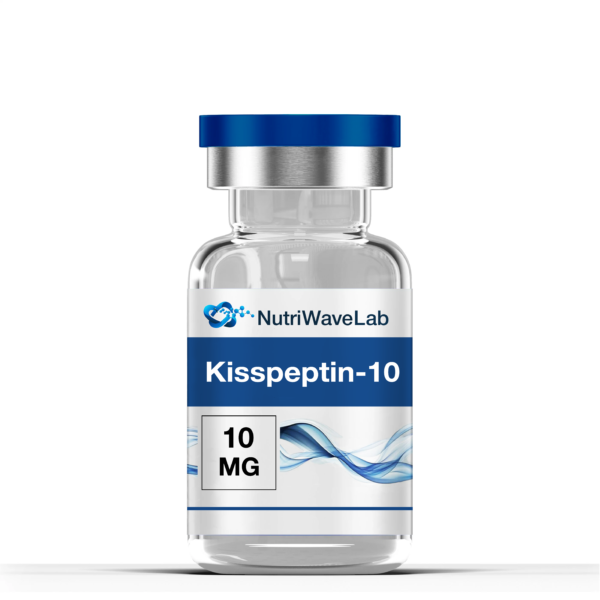Kisspeptin-10 10mg
$0.00
- when buying 5 units of goods 5% discount
- when buying 10 units of goods 8% discount
11 in stock
Kisspeptin-10 — Neuroendocrine Peptide Involved in Reproductive and Metabolic Regulation
Chemical and Biochemical Characteristics
-
Peptide Name: Kisspeptin-10 (Kp-10)
-
Amino Acid Sequence: Tyr-Asn-Trp-Asn-Ser-Phe-Gly-Leu-Arg-Phe
-
Molecular Formula: C₆₃H₈₃N₁₇O₁₄
-
Molecular Weight: 1302.4 g/mol
-
PubChem CID: 25240297
-
Synonyms: KISS-1, Metastin fragment, Kp-10, Kisspeptin fragment (1-10)
-
Peptide Class: Neuroendocrine regulatory peptide / reproductive axis modulator
Overview
Kisspeptin-10 is a short, bioactive fragment of the KISS-1 protein, a naturally occurring neuropeptide family that plays a central role in reproductive hormone regulation.
Produced in the hypothalamic neurons, Kisspeptin binds to the GPR54 (Kiss1R) receptor, triggering gonadotropin-releasing hormone (GnRH) secretion — the key upstream signal controlling luteinizing hormone (LH) and follicle-stimulating hormone (FSH) release from the anterior pituitary.
Due to its pivotal position in the hypothalamic–pituitary–gonadal (HPG) axis, Kisspeptin-10 is widely studied as a research model for reproductive disorders, endocrine signaling, and neurobehavioral physiology.
Mechanism of Action
-
GnRH stimulation: Activates Kiss1R on GnRH neurons, inducing pulsatile GnRH and downstream LH/FSH release.
-
Feedback regulation: Its secretion is tightly modulated by circulating sex steroids, linking gonadal feedback with hypothalamic signaling.
-
Neuroendocrine integration: Participates in communication between metabolic, reproductive, and emotional circuits of the brain.
-
Peripheral actions: Kisspeptin and its receptors are also expressed in the pancreas, kidneys, and cardiovascular tissues, suggesting multi-system roles【1】【2】.
Reproductive Axis and Hormonal Effects
Human and animal studies demonstrate that Kisspeptin-10 potently stimulates LH release and enhances testosterone production in males【3】【4】.
Bolus administration increases LH pulse frequency, while continuous infusion sustains gonadotropin output over several hours.
In females, Kisspeptin signaling coordinates ovulatory LH surges and fine-tunes steroid feedback sensitivity, providing insights into polycystic ovary and functional hypothalamic amenorrhea research models.
Because it preserves endogenous GnRH activity, Kisspeptin-10 is often explored as a potential adjunct in fertility and HPG restoration studies.
Energy Balance and Metabolism
Beyond reproduction, Kisspeptin neurons integrate energy status with fertility signaling.
Experimental evidence indicates that the hypothalamic Kiss1 network senses changes in metabolic hormones such as leptin, ghrelin, and PYY3-36, adjusting GnRH output according to nutritional state【5】.
Animal models show that disrupted Kisspeptin signaling contributes to hypogonadism under caloric restriction, while Kisspeptin-10 administration can restore neuroendocrine balance in energy-deficient states.
This cross-talk highlights Kisspeptin as a bridge between metabolism, reproduction, and homeostatic regulation.
Neurobehavioral and Mood Regulation
Recent neuroimaging studies in humans reveal that Kisspeptin modulates limbic and hypothalamic connectivity, influencing emotional and sexual brain processing【6】【7】.
Subjects receiving Kisspeptin infusions demonstrated enhanced positive affect and reduced negative emotional reactivity, suggesting neuromodulatory roles in affective and reward circuits.
Preclinical models also report antidepressant-like and anxiolytic effects, indicating a broader role for Kisspeptin-10 in mood and motivation research.
Memory and Cognitive Studies
In rodent models, intracerebral administration of Kisspeptin has been shown to improve memory retention and cognitive flexibility, potentially through modulation of hippocampal synaptic plasticity and BDNF expression【8】.
These findings open investigation pathways linking Kisspeptin to learning, stress adaptation, and neuroplasticity.
Oncology and Anti-Metastatic Research
The KISS-1 gene, first identified as a metastasis-suppressor, encodes peptides including Kisspeptin-10 that can inhibit tumor cell invasion and migration.
Experimental studies show anti-metastatic activity in melanoma, breast, ovarian, and mesothelioma cell lines, mediated by suppression of MMP-9 and angiogenic factors【9】【10】.
Kisspeptin signaling has therefore become a key model in cancer biology, representing an intersection of hormonal regulation and tumor progression control.
Renal and Cardiovascular Insights
Kisspeptin receptors are expressed in renal tubules and vascular endothelium, implicating Kp-10 in glomerular development and vasomotor regulation.
Animal studies suggest that Kisspeptin may modulate angiogenesis and vascular tone, contributing to the maintenance of circulatory homeostasis【11】.
These findings align with its anti-angiogenic and anti-metastatic mechanisms observed in tumor research.
Summary
Kisspeptin-10 is a multifunctional neuroendocrine peptide with crucial roles in reproductive axis control, metabolic regulation, emotional processing, and anti-metastatic signaling.
Its diverse receptor interactions and systemic presence make it a valuable subject for research into:
-
Hypothalamic–pituitary–gonadal (HPG) regulation
-
Energy balance and metabolic neuroendocrinology
-
Mood, cognition, and limbic modulation
-
Cancer metastasis and vascular remodeling
All Kisspeptin-10 preparations are intended solely for laboratory research and not for human administration.
Selected References
-
Dhillo W.S. et al. Kisspeptin-54 stimulates the hypothalamic-pituitary-gonadal axis in human males. J Clin Endocrinol Metab, 2005; 90(12): 6609–6615. PubMed
-
George J.T. et al. Kisspeptin-10 is a potent stimulator of LH and pulse frequency in men. J Clin Endocrinol Metab, 2011; 96(8): E1228–E1236. PubMed
-
Harter C.J.L., Kavanagh G.S., Smith J.T. The role of kisspeptin neurons in reproduction and metabolism. J Endocrinol, 2018; 238(3): R173–R183. PubMed
-
Mead E.J. et al. Kisspeptins: multifunctional peptides in reproduction, cancer and cardiovascular regulation. Br J Pharmacol, 2007; 151(8): 1143–1153. PubMed
-
Ly T., Harihar S., Welch D.R. KISS1 in metastatic cancer research and treatment. Cancer Metastasis Rev, 2020; 39(3): 771–787. PubMed
-
Comninos A.N. et al. Kisspeptin modulates sexual and emotional brain processing in humans. J Clin Invest, 2017; 127(2): 709–719. PubMed
-
Pazarci P. et al. Daylight exposure, melatonin, and Kiss1 expression in melanoma formation in mice. Croat Med J, 2020; 61(1): 55–61. PubMed
-
Gibula-Tarlowska E., Kotlinska J.H. Kissorphin improves spatial memory after ethanol treatment in rats. Behav Pharmacol, 2020; 31(2–3): 272–282. PubMed
-
Bhattacharya M., Babwah A.V. Kisspeptin: Beyond the Brain. Endocrinology, 2015; 156(4): 1218–1227. PubMed
-
Zhou Y. et al. Antitumor efficacy of Kisspeptin in human malignant mesothelioma cells. Front Oncol, 2018; 8: 177. PubMed
-
Mead E.J. et al. Cardiovascular and renal distribution of Kisspeptin receptors. Br J Pharmacol, 2007; 151(8): 1143–1153. PubMed
Product Use: THIS PRODUCT IS STRICTLY FOR
SCIENTIFIC RESEARCH PURPOSES ONLY. It should only be used in laboratory
settings. All product information on this website is provided solely for
educational purposes. The law strictly prohibits introducing this product into
the body of humans or animals. Only licensed professionals should handle this
product. This product is not a drug, food, or cosmetic and should not be
improperly classified or used as such.



Reviews
Clear filtersThere are no reviews yet.